Radio base station
a radio station and base station technology, applied in power management, transmission path division, high-level techniques, etc., can solve the problems of receiving broadcast information, unable to recognize call termination, and unable to describe the transmission period of system information, so as to reduce the convergence of inter-frequency measurement period allocated to multiple mobile stations
- Summary
- Abstract
- Description
- Claims
- Application Information
AI Technical Summary
Benefits of technology
Problems solved by technology
Method used
Image
Examples
first embodiment
[0106]In the first embodiment described with reference to FIG. 10, the inter-frequency-measurement-period allocator 16 decides whether or not any one of the subframe numbers ASNs, BSNs, and CSNs to be avoided is included in a block that has a length of the measurement gaps and is constituted of multiple consecutive subframes. If any one of the subframe numbers ASNs, BSNs, and CSNs to be avoided is not included in the block, the inter-frequency-measurement-period allocator 16 selects the block as the measurement gap and allocates the measurement gap to the mobile station. If any one of the subframe numbers ASNs, BSNs, and CSNs to be avoided is included in the block, the inter-frequency-measurement-period allocator 16 designates a next block shifted from the block by one subframe and decides whether or not any one of the subframe numbers ASNs, BSNs, and CSNs to be avoided is included in the next block. By repeating the process while shifting the block by one subframe, a block that is ...
second embodiment
[0128]In the second embodiment described with reference to FIGS. 11 and 12, in each decision, the inter-frequency-measurement-period allocator 16 decides whether or not any one of the subframe numbers ASNs, BSNs, and CSNs to be avoided is included in a block that has the length of the measurement gaps and is constituted of multiple consecutive subframes. If any one of the subframe numbers ASNs, BSNs, and CSNs to be avoided is not included in the block, the inter-frequency-measurement-period allocator 16 selects the block as the measurement gap and allocates the measurement gap to the mobile station. If any one of the subframe numbers ASNs, BSNs, and CSNs to be avoided is included in the block, the inter-frequency-measurement-period allocator 16 designates a next block shifted from the block by the length of six subframes (the length of the block, i.e., the length of the measurement gap) or the length of five subframes, and decides whether or not any one of the subframe numbers ASNs,...
PUM
 Login to View More
Login to View More Abstract
Description
Claims
Application Information
 Login to View More
Login to View More - R&D
- Intellectual Property
- Life Sciences
- Materials
- Tech Scout
- Unparalleled Data Quality
- Higher Quality Content
- 60% Fewer Hallucinations
Browse by: Latest US Patents, China's latest patents, Technical Efficacy Thesaurus, Application Domain, Technology Topic, Popular Technical Reports.
© 2025 PatSnap. All rights reserved.Legal|Privacy policy|Modern Slavery Act Transparency Statement|Sitemap|About US| Contact US: help@patsnap.com



